If you are looking for guides to learn how to record piano, you came to the right place. In this post, you will find the answer.
The piano recording is a challenging task. It’s not an acoustic guitar to just place the mic in front of it and start playing.
The piano needs a couple of mics to capture the best sound. Also, piano recording should have some ambient to it. Room sound is very important for piano recording.
In this piano recording guide, you will learn how to mic and record upright and grand pianos.
Although you might not have an acoustic piano in your home recording studio, it’s good to know how to record a piano. It might come in handy in the future.
Prepare For Recording Piano At Home
The first thing you need to do when recording piano, is to prepare for it. You need to create a recording environment, tune your piano, plan microphone placements, etc.
Tune The Piano

Of course, any instrument must be in tune for recording. If an instrument is out of tune, there will be many issues with the recording.
So, you need to tune your piano to make sure that every note sounds perfect. And tuning a piano is a lot harder than a guitar for example.
If you don’t know how to tune a piano, you can watch or read tutorials. Also, you can use piano tuning services.
Open Piano Lids
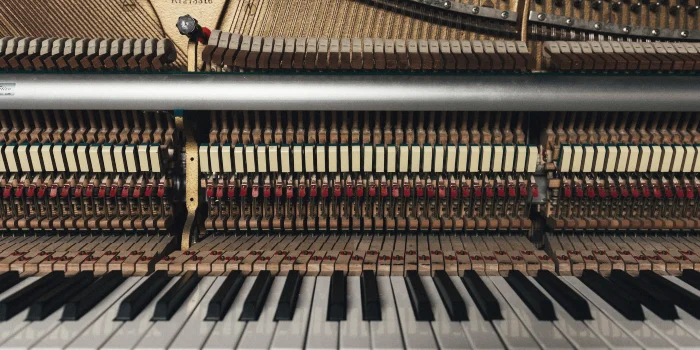
The piano should have its lids fully open for recording. That’s where sound is coming from and you want to capture it with microphones.
No matter what type of piano you are recording – upright, grand, or other – always open the lids fully.
Microphones can’t capture a good sound if piano lids are closed. But if you like experiments and want to have a unique sound, you can leave them closed.
But in general, for a good piano recording sound, piano lids should be open.
Choose A Piano Microphone
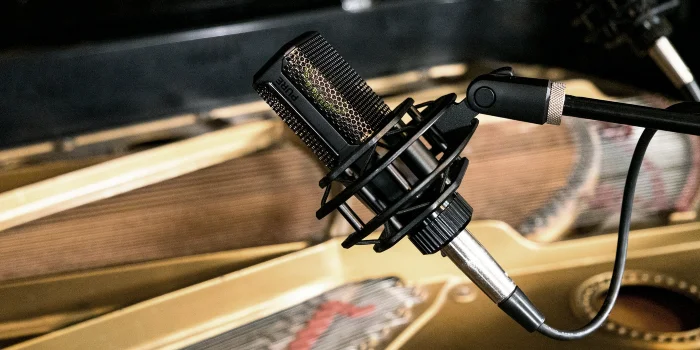
And lastly, choose microphones for piano recording. Microphone perhaps is the most important gear when you record piano or other acoustic instruments. Your piano sound heavily depends on the mic.
But don’t try to buy an expensive mic. Many affordable microphones are great for recording. The important thing is the microphone type.
The sound depends on personal preferences. You can use a dynamic or condenser mic. Both types are great to record pianos.
In general, a dynamic microphone should be close to the piano. It will capture a more focused sound.
On the other hand, a condenser mic can be placed a little further from the piano and it will capture a more broad sound. It will have more ambient sound.
But what you can do and perhaps it’s the best solution, is to use a mic combination. Using both types of microphones will make your piano recording better and more natural.
If you decide to use multiple mics, place dynamic mics closer to the piano for focused sound. And place condenser mics further from the piano and add ambient and reverb to your sound.
Piano Mic Placement
After you prepare your piano for recording, tune it and choose the mics, it’s time to place your mics in the best spots to capture as good sound as possible. Microphone placement is the key to good sound.
Like acoustic guitar recording, you need to properly place your microphones when you record a piano. And there are many different ways to do it.
The only thing that matters is to use more than one microphone. The piano sound will be better, rich, and more natural. Although, if you want to get a specific or mono sound, you can record your piano with only one mic.
Now let’s see how to mic upright and grand piano to capture and record the best sound possible. Both piano types require a different approach to capture their sound.
Upright Piano Mic Placement
Most home recording studios will have an upright piano rather than a grand piano. It’s smaller in size, can fit in most rooms, and it’s easier to record.
Upright pianos can be placed beside a wall and there will be no problems. And you can record upright piano with only two mics. But for this guide, we will use three mics.
Two mics will be dynamic which will capture the core sound. And one condenser mic will capture the sound with a little ambient.
You will have three piano tracks that allow you to create stereo sound with panning. Also, you can blend the sounds together.
First, open the top lid and front panel. You want to capture the open sound of the piano. Most upright pianos will have a top lid and a removable front panel, at the bottom.
A condenser mic goes on the top of the piano. It must be in the center and about 6″ or 8″ from the piano. It will have a small ambient to it which creates a natural reverb.

Two dynamic microphones go to the bottom part of the piano, where you removed the panel. Mics go to the sides and a good distance between mics and the piano is 8″ to 11″.
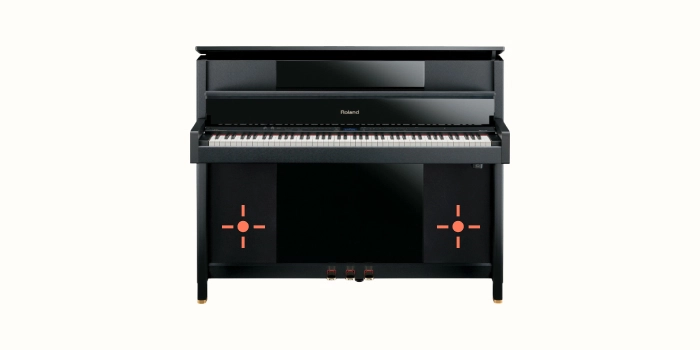
This way you will have two, focused sounds of the piano that you can pan left and right. Additionally, you will have a third, more ambient-sounding track that you can blend with the previous two tracks.
However, you can use only dynamic or condenser mics. But good practice is to have different types of mics for richer and more diverse sounds.
If you have only one mic then it’s better to place it on the top and record that way. It will give you the best possible sound you can record with only one microphone.
Grand Piano Mic Placement
Although almost no home recording studio will have a grand piano, it’s good to know how to record a grand piano. Also, grand piano micing techniques can come in handy for upright piano recording.
When you record the grand piano, it’s better to place it in the center of the room. It needs space to fully capture its sound. Don’t place the grand piano near the wall. Give it some space to breathe.
The best and easiest way to record grand piano is to use two microphones. It can be the same type of microphone or two different ones. Depends on what you have and what are your preferences.
One microphone should be placed on the far right side from the player’s point of view. The lid must be open and the distance between the mic and the piano should be about 8″.
And the second mic should go to the far left side, far from the player. Distance should be the same.
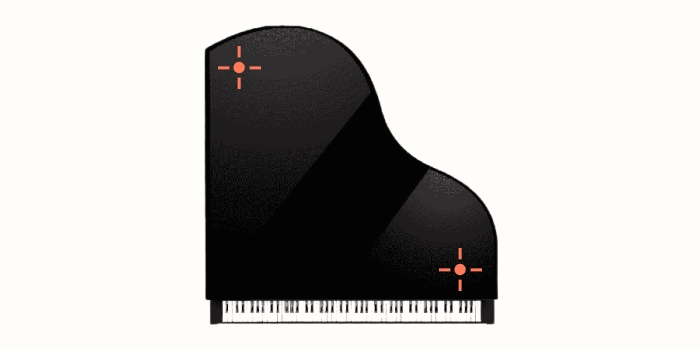
This grand piano mic placement will create a wider piano sound. No matter what types of microphones you use. And it will allow you to have a stereo piano recording. You can pan it on the sides or blend two tracks.
But if you have only one mic, you can still record your grand piano. The best option for one mic recording is to place it in the center of the instrument.
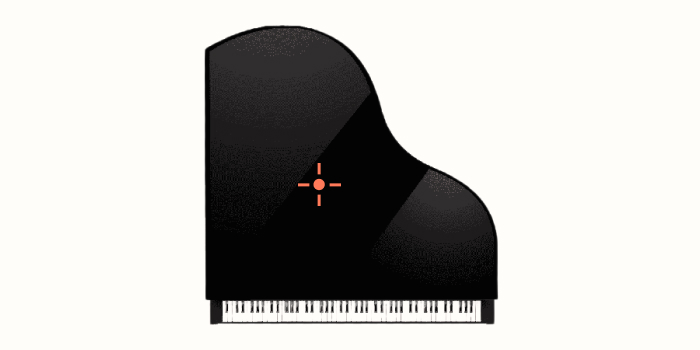
The sound won’t be as rich as with two mics but it still is a good-sounding recording. Perhaps the condenser mic is the best option when you record a piano with one mic. It will have a small ambient to it.
7 Mic Technique To Record Piano
Of course, there are hundreds of different recording techniques for pianos. There are no rules and you can create your own techniques and methods to record pianos.
One of the best methods to record piano is the 7-mic technique. The piano will have a more natural and ambient sound with this method.
But this method won’t work all the time. Some songs require a more straightforward approach. This technique is great if you want to create a spacious piano sound. This 7-mic method works for every type of piano.
What you need to do is to place a piano in the center of the room, open the lids, and place six mics around the piano and one on the top. The distance between the mics and the piano should be around 5 to 7 feet. The top mic could be closer.
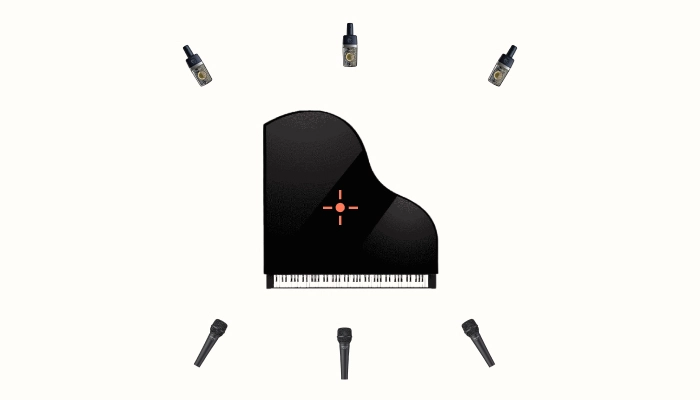
And the combination of mics could be different, depending on your preferences. You can use dynamic mics for the front and condensers for the back. Or mix them. The top mic should be a condenser.
What you will get are the seven different tracks of your piano recording. You can blend these tracks and get a huge piano sound with an ambient. Also, you can pan them and you will have a great stereo sound.
This method is more suitable for bigger rooms but you can still do it in your home recording room. You can use upright piano and instead of seven mics, use five or four.
The goal is to capture piano sound with the room sound to capture the ambiance and have natural reverb.
Conclusion
Knowing how to record piano is a great advantage for every home recording or mixing engineer. The piano is a great instrument and requires some knowledge to get a great sound. But when you know how to place microphones to capture the best sound of a piano, it will be easier for you.
You can try the methods discussed in this post and see the results for yourself. Also, according to these techniques, you can create your custom mic placement for pianos.
